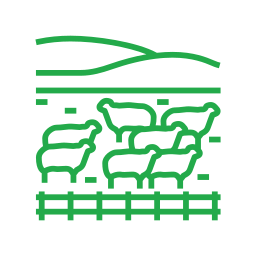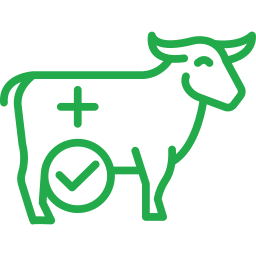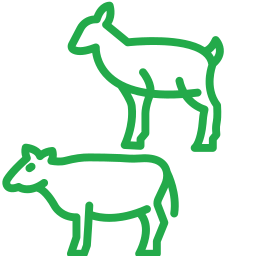Standards
1. Pasture and Biodiversity Sustainability
According to the Law on the Legal Status of Primary Herder Household Associations, herders organize themselves into Primary Herder Household Associations and enter into long-term pasture-use contracts with the soum governor. Through this arrangement, the nomadic livestock husbandry system is preserved, ensuring the proper functioning of the pasture ecosystem and the sustainability of biodiversity.
Within the proper functioning of the pasture ecosystem, the habitats of biodiversity are protected, thereby stabilizing the balanced coexistence between wildlife and nomadic livestock husbandry. By safeguarding herders’ traditional rights to pasture use through contractual agreements and fostering responsible utilization, the sustainability of the pasture ecosystem is ensured. The benefits and impacts of this management are assessed and evaluated through pasture photo monitoring.
2. Sustainable raw material economy from livestock products
In accordance with the Responsible Nomadic and Sustainable Pastoral Livestock Standard, herders will produce livestock-based raw materials such as meat, milk, cashmere, wool, and hides in a sustainable and high-quality manner that meets the requirements of both domestic and international markets. This will be achieved by ensuring healthy livestock, sound breeding and selection, and proper animal welfare.
Adhering to high quality standards enhances the market value of products, builds consumer trust, preserves the traditional nomadic way of livestock husbandry, and contributes to the protection of the pasture ecosystem.
3. Requirements for animal feeding, care, and herding

MNS 6891:2025 National Standard for Responsible Nomadic Pastoral Livestock Practices
The requirements for livestock feeding, care, and herding are aimed at ensuring the five freedoms of animal welfare.
According to the World Organisation for Animal Health (WOAH), the five freedoms of animal welfare are:
(i) Freedom from hunger and thirst – livestock must have sufficient pasture available during all four seasons. In winter and spring, when pasture resources are scarce, supplemental feed must be prepared and provided for no less than three months according to proper rations and norms.
(ii) Freedom from fear and distress – livestock must be herded in groups without using methods that cause fear, pressure, or panic. Frightening or stressful techniques must be avoided, and herding should be done using traditional means.
(iii) Freedom from physical discomfort and extreme weather – winter and spring shelters must provide warmth, fenced enclosures, dry bedding with dung flooring, and pastures in all four seasons must ensure sufficient access to water sources.
(iv) Freedom from pain, injury, and disease – livestock must be protected from injuries during care, handling, transport, and movement. Sick animals must be treated in each case, and all animals must be fully included in veterinary preventive and curative measures in a timely manner. Harnesses and animal equipment must be made from leather or wool.
(v) Freedom to express normal behavior – livestock must be allowed to graze in properly chosen pastures, maintain body condition, and be protected from abnormal losses. Such good practices must be established to fully ensure the highest level of animal welfare.
4. Requirements for animal health
Nomadic herders must have herds that are either free from highly contagious animal diseases (such as foot-and-mouth disease, peste des petits ruminants, sheep and goat pox, lumpy skin disease in cattle, goat plague, African swine fever, and classical swine fever) or herds that have full immunity against these diseases.
For zoonotic diseases (those transmissible from animals to humans, such as anthrax, rabies, brucellosis, tuberculosis, and listeriosis), herds must likewise be free or protected.
To prevent infection:
- When bringing in animals from outside or selling livestock, veterinary certificates must be obtained from healthy regions under the supervision of veterinary authorities.
- Newly introduced animals must be kept in quarantine for at least 14 days before being integrated into the main herd.
- If signs of highly contagious or zoonotic diseases appear, the sick animals must be isolated from the herd, and the soum veterinarian must be notified within 12 hours.
- Dead animals must be buried and disposed of properly, and transport vehicles and enclosures used for livestock must be disinfected by professional organizations.
Regarding veterinary medicines:
- Herders must obtain veterinary drugs from their contracted veterinary service providers.
- Prescription medicines must be administered by veterinarians, and required withdrawal periods must be strictly observed.
- Herders must contract with veterinary service providers for animal health services, and each time services are provided, records must be entered into the veterinary registration logbook.
5. Requirements for animal breeding, selection, and herd reproduction
Herders must regularly maintain records of breeding and nucleus herds, cull animals, and offspring growth. In addition, their traditional livestock herding methods must be registered with the soum agricultural department.
When conducting breeding and selection work to improve livestock breeds, herders must make selections from the entire herd based on qualitative traits (such as coat color, horns, hooves, body conformation, ear shape) and quantitative traits (such as live weight, milk yield, milk fat content, wool and cashmere yield, cashmere fineness). From this, elite and first-class breeding females must be selected, and corresponding nucleus and elite breeding males must be chosen in accordance with the regional breeding direction.
Breeding work must be carried out purposefully and in alignment with precise record-keeping. By maintaining the proper ratio of large and small livestock, and ensuring the correct balance between breeding females and males, the incidence of infertility is reduced and the normal conditions for herd reproduction are established.




